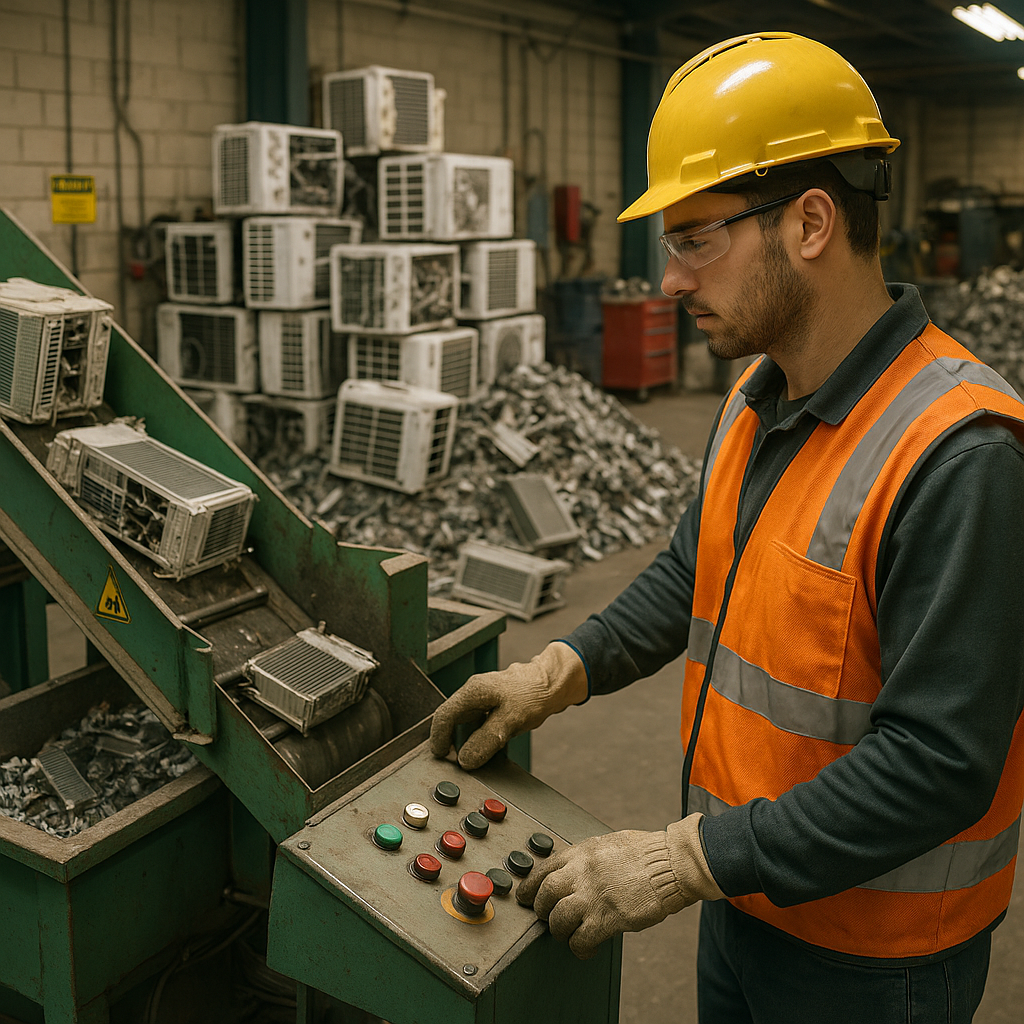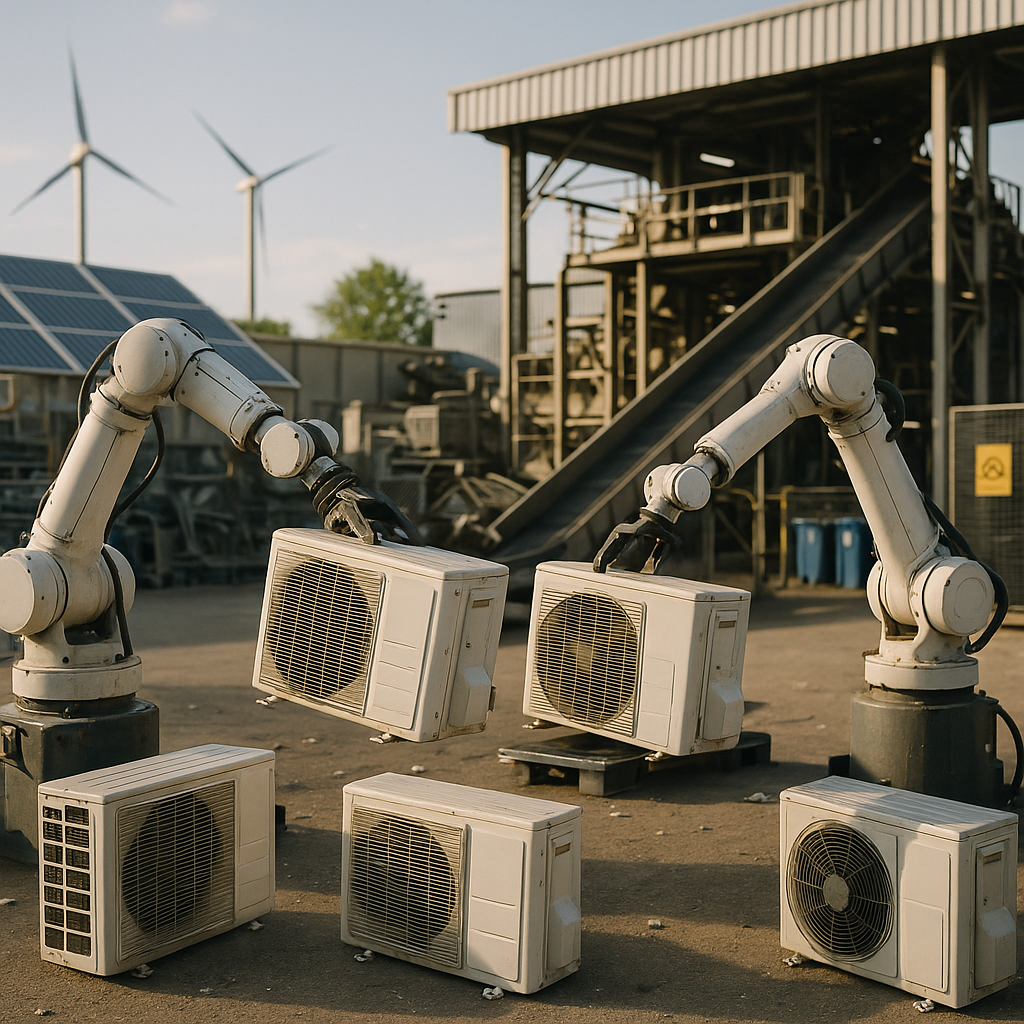5901 Botham Jean Blvd, Dallas, TX 75215
The Role of Large AC Unit Recycling in Reducing Landfill Waste
May 13, 2025Recycling a single air conditioner can recover up to 65 pounds of recyclable materials. This EPA statistic underscores the significant impact of AC unit recycling on reducing waste. Each unit diverted from landfills makes a noticeable difference.
Recycling large AC units is crucial in addressing our growing landfill crisis. These bulky HVAC systems take up substantial space at disposal sites and contain valuable metals and components that can be repurposed. Proper recycling prevents these systems from spending centuries degrading in landfills.
The environmental benefits go beyond space conservation. Effective AC recycling prevents harmful refrigerants and chemicals from contaminating soil and groundwater. It also reduces the need for new raw material extraction, conserving natural resources and lowering the carbon footprint of HVAC manufacturing.
What Components of Large AC Units Can Be Recycled?
Large AC units contain a wealth of recyclable materials. When these systems reach the end of their life, they can yield up to 65 pounds of recoverable components. Properly dismantling these units ensures valuable resources are not sent to landfills.
Copper is the most valuable material in air conditioning systems. Found primarily in cooling coils and electrical wiring, copper commands high recycling prices due to its conductivity and versatility. Recycling copper uses just 10% of the energy needed to mine and process new copper ore.
Aluminum components account for significant portions of AC units, particularly in fins, condenser coils, and structural frameworks. This lightweight metal is 100% recyclable and retains its properties indefinitely through the recycling process.
Key Recyclable Components
The recyclable materials in large AC units include:
- Metals: Steel housing and brackets, brass valves, and iron components
- Plastics: Fan blades, housing components, and insulation materials
- Electronic Parts: Circuit boards contain precious metals like gold, silver, and platinum
- Refrigerants: These must be properly extracted by certified professionals before recycling
The extraction process requires careful dismantling. Specialized recycling facilities separate these materials through mechanical processes. Steel and other ferrous metals are pulled out with magnets, while other components require manual separation.
Proper recycling of these materials delivers substantial environmental benefits. It reduces mining impact, conserves energy, and prevents hazardous substances from entering landfills. For example, recycling one ton of aluminum conserves about 14,000 kilowatt-hours of electricity compared to mining new aluminum.
Environmental Benefits of Component Recycling
The environmental impact of recycling AC components extends beyond waste reduction. Recycling metals like copper and aluminum dramatically reduces the energy consumption associated with mining raw materials, thus reducing carbon emissions.
Steel components in AC units can be recycled repeatedly without loss of strength, creating a closed-loop system where materials maintain their usefulness across multiple product lifecycles. Each ton of recycled steel saves 1,400 pounds of coal and 120 pounds of limestone.
Plastics from AC units can be processed into new products rather than languishing in landfills for centuries. Modern recycling techniques can transform these plastics into everything from outdoor furniture to construction materials.
Electronic components contain small amounts of precious metals that are increasingly scarce in natural deposits. Recycling these parts helps conserve these limited resources while preventing toxic elements from contaminating soil and water.
Beyond the environmental benefits, component recycling creates economic opportunities. The recovery industry supports jobs in collection, processing, and manufacturing sectors. These positions range from technical specialists who safely extract refrigerants to engineers who design more recyclable AC systems.
How Does the AC Unit Recycling Process Work?

The AC unit recycling process involves a series of steps to maximize resource recovery while protecting the environment. Each phase is critical to ensuring harmful materials are contained and valuable resources are reclaimed.
The process begins with certified technicians safely removing refrigerants from the unit. These chemicals, such as hydrochlorofluorocarbons (HCFCs) and hydrofluorocarbons (HFCs), pose environmental risks if released. They have high global warming potential and can deplete the ozone layer. Technicians use specialized equipment to capture these substances in secure containers for proper recycling or destruction at EPA-certified facilities.
After the refrigerant is removed, the unit enters the dismantling phase. Skilled workers carefully disassemble the air conditioner, separating components based on material composition. This meticulous disassembly ensures various materials don’t contaminate each other during recycling.
The sorting phase uses advanced technology to separate materials efficiently. Magnetic systems extract ferrous metals, while eddy current systems isolate non-ferrous metals like aluminum. These sophisticated sorting techniques maximize the recovery of valuable materials that might otherwise end up in landfills.
Copper recovery is one of the most valuable aspects of the process. AC units contain significant amounts of copper in coils, wiring, and other components. Recycling copper requires up to 85% less energy than mining and refining new copper. The environmental savings are substantial—recycling one ton of copper can conserve approximately 40 million BTUs of energy.
Plastics and other non-metallic components follow their own recycling paths. These materials are sorted by type and sent to specialized facilities for processing into raw materials for new products. This comprehensive approach ensures minimal waste from the original unit.
The final stage involves processing the sorted materials for reuse in manufacturing. The recovered copper, aluminum, steel, and plastics become valuable raw materials, reducing the need for virgin resource extraction. This closed-loop system exemplifies the circular economy, where resources are continuously reused rather than discarded.
Recycling air conditioning units through this systematic process achieves multiple environmental benefits. It prevents hazardous materials from entering landfills and potentially leaching into soil and groundwater. It reduces greenhouse gas emissions associated with manufacturing new materials. Most importantly, it conserves valuable natural resources for future generations.
The efficiencies gained through proper AC unit recycling are remarkable. The energy saved, pollution prevented, and resources conserved make this process an essential component of sustainable waste management practices.
What Are the Environmental Benefits of Large AC Unit Recycling?
When large AC units reach the end of their service life, recycling offers substantial environmental advantages over landfill disposal. These benefits span multiple ecological dimensions, positively impacting our planet’s health.
Proper recycling of AC units significantly reduces landfill burden. These bulky systems would otherwise occupy valuable space in already-strained waste facilities. More importantly, recycling prevents harmful substances in AC units from leaching into soil and contaminating groundwater.
The copper recovery aspect of AC recycling delivers impressive environmental returns. Recycling copper from air conditioning systems requires up to 85% less energy than mining and refining new copper, resulting in a significantly smaller carbon footprint.
The energy savings are substantial. According to the Environmental Protection Agency, recycling just one ton of copper saves approximately 40 million BTUs of energy, equivalent to the annual electricity consumption of 4-5 average American households.
By reducing demand for new mining operations, AC unit recycling helps preserve natural landscapes and ecosystems. Copper mining is notorious for its environmental impact, including deforestation, habitat destruction, and water pollution. Every recycled AC unit directly contributes to decreasing these damaging activities.
Climate change mitigation represents another critical benefit. The reduced energy consumption in recycling processes versus mining leads to significantly lower greenhouse gas emissions, making AC recycling an important component in efforts to combat global warming.
In the waste management hierarchy, recycling ranks far above landfill disposal. AC units contain valuable materials beyond copper, including aluminum, steel, and other metals that can be repurposed through proper recycling channels. This circular approach keeps resources in productive use rather than buried as waste.
The refrigerants in AC units pose particular environmental hazards if improperly handled. Professional recycling ensures these substances are safely extracted and processed, preventing their release into the atmosphere where they would contribute significantly to ozone depletion.
| Aspect | Virgin Copper Production | Recycled Copper Production |
| Energy Consumption | High | 85% less than virgin production |
| Carbon Emissions | High | Significantly lower |
| Environmental Impact | Significant due to mining | Reduced due to less energy use and emissions |
| Resource Conservation | Consumes natural resources | Conserves resources by reusing copper |
| Waste Management | Generates mining waste | Reduces landfill use |
As we face growing environmental challenges, the cumulative impact of responsible AC unit recycling becomes increasingly significant. Each unit diverted from landfills represents a small but meaningful step toward environmental protection and resource conservation, highlighting the importance of proper end-of-life management for these common but resource-intensive appliances.
Conclusion: The Future of Large AC Unit Recycling

Large AC unit recycling is crucial for environmental conservation. These units contain valuable materials like copper, aluminum, and steel that can be recovered and repurposed. Proper recycling not only diverts bulky equipment from landfills but also significantly reduces the demand for new raw materials. The environmental benefits extend beyond resource conservation, as the proper handling of refrigerants prevents the release of substances far more damaging to our atmosphere than carbon dioxide.
The future of large AC unit recycling looks promising as technological innovations continue to enhance recovery processes. Advanced sorting systems, specialized refrigerant extraction methods, and more efficient material separation techniques are making recycling increasingly effective. As environmental regulations tighten and public awareness grows, the importance of responsible AC unit disposal will intensify. By choosing certified recycling programs for your old air conditioning units, you actively contribute to building a circular economy where today’s waste becomes tomorrow’s resources. For your commercial or residential AC recycling needs, contact Okon Recycling at 214-717-4083.
